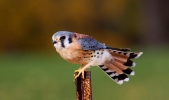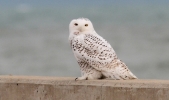Sexual selection is a special case of natural selection in which the traits being selected for are directly related to mating success. As with natural selection, sexual selection was first described by Charles Darwin in On the Origin of Species:
“This leads me to say a few words on what I have called Sexual Selection. This form of selection depends, not on a struggle for existence in relation to other organic beings or to external conditions, but on a struggle between the individuals of one sex, generally the males, for the possession of the other sex. The result is not death to the unsuccessful competitor, but few or no offspring.”
Sexually selected adaptations serve to make an individual more attractive to potential mates (intersexual selection) and/or able to outcompete members of their own sex for access to mates (intrasexual selection). One of the easiest ways to determine which traits might be a result of sexual selection is to look for differences between the males and females (i.e., sexual dimorphism), as described by Darwin:
“…when the males and females of any animal have the same general habits of life, but differ in structure, colour, or ornament, such differences have been mainly caused by sexual selection: that is, by individual males having had, in successive generations, some slight advantage over other males, in their weapons, means of defence, or charms, which they have transmitted to their male offspring alone.”
Birds possess a variety of sexually selected traits, including some truly spectacular examples. Adaptations that result from sexual selection in birds are usually related to plumage, song, and/or behavior:
Plumage
Perhaps the best-known plumage trait that likely arose through sexual selection is the “train” of the male Indian Peafowl (peacock), Pavo cristatus. These fantastically elongated upper tail coverts are raised and fanned in displays to females. Evidence suggests that females prefer males with more eyespots in their trains. Thus, over time, males have evolved longer trains with more eyespots because longer-trained males father more young (and the trait is heritable). In addition to the Indian Peafowl, scores of bird species have elaborate tails or upper tail coverts that are the result of sexual selection, including Marvelous Spatuletail (Loddigesia mirabilis), Resplendent Quetzal (Pharomachrus mocinno), Ribbon-tailed Astrapia (Astrapia mayeri), and Long-tailed Widowbird (Euplectes progne).
Song
The Superb Lyrebird (Menura novaehollandiae) of Australia possesses one of the most extraordinary songs among birds. Its ability to mimic other sounds likely is unrivaled, giving lyrebirds immense vocal repertoires. Lyrebirds utilize these large repertoires as part of a display to attract females. Although a male lyrebird also incorporates extravagant tail feathers and dancing into his display, song repertoire presumably plays a very important role in whether a female chooses to mate with him. Thus, a lyrebird now has an extremely complex syrinx (the vocal organ of birds) and can incorporate into its song sounds such as the songs of other birds, the calls of koalas and dingos, car alarms, chainsaws, camera shutters, and crying babies.
Behavior
In addition to, and often in combination with, plumage and song, sexual selection has resulted in a variety of mating behaviors in birds. Some behaviors are utilized for intrasexual competition for mates, but the best-known are those used to attract mates (almost always males trying to attract females). Some of the most spectacular display behaviors are found among the bowerbirds of Australia and New Guinea. Males of many species in this family (Ptilonorhynchidae) construct and decorate bowers—structures of varying size, design, and complexity—to woo females. Possibly the largest bowers are built by male Vogelkop Bowerbirds (Amblyornis inornata), which are endemic to the Vogelkop Peninsula in western New Guinea. Its cone-shaped, hut-like bowers can be over three feet tall and more than five feet in diameter! But perhaps the most amazing aspects of its bower (and other species’ bowers) are the decorations. The males go to great lengths to gather objects it deems to be beautiful and to then artistically arrange them around the entrance to the bower. These decorations can include colorful flowers, berries, beetle wing covers, fungi, leaves, and even aluminum cans. Each male’s decorations are unique and reflect his own personal taste. The females will visit several bowers in a forest area and mate with the male whose decorated bower appeals to her the most. These elaborate bowers, despite the effort required to build them, serve no purpose in nesting or young raising; they are purely for mate attraction, showing the strength that sexual selection can exhibit on behavior.








